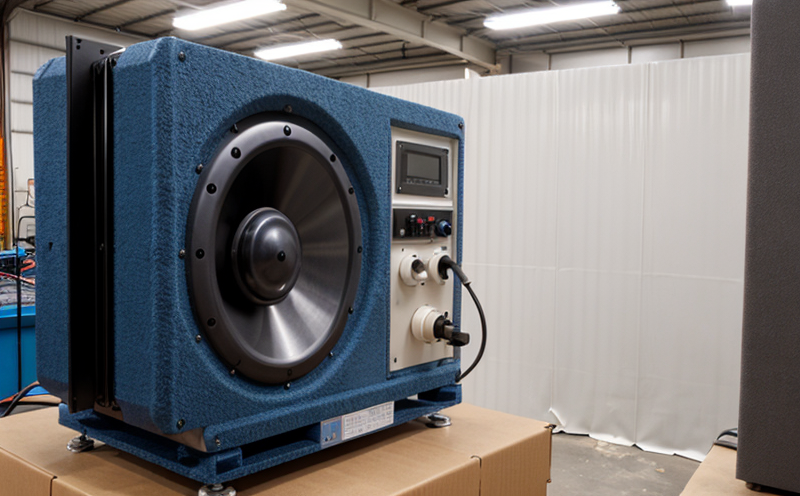IEC 60704-2-12 Sewing Machine Noise Testing
The International Electrotechnical Commission (IEC) standard IEC 60704-2-12 provides a robust framework for the testing and evaluation of noise generated by sewing machines. This standard is particularly important in ensuring that products meet the stringent requirements set forth to protect consumer health and safety, especially when dealing with high-frequency sounds produced during operation.
One of the primary goals of this test procedure is to ensure that sewing machine noise does not exceed acceptable limits as defined by regulatory bodies worldwide. Compliance with these standards is crucial for manufacturers aiming to enter international markets where stringent environmental regulations are in place. The standard covers both stationary and portable sewing machines, including those used in various environments such as home use, commercial settings, or industrial applications.
The test methodology outlined in IEC 60704-2-12 involves several steps aimed at accurately measuring noise levels across different frequency bands relevant to human hearing. A key aspect of this process is the selection and preparation of the sewing machine for testing. This includes ensuring that all components are assembled correctly according to manufacturer specifications, which can vary based on model type. Additionally, any accessories used during normal operation should also be included in the test setup.
Once the equipment has been prepared, the next step is placing it into a specially designed anechoic chamber or room where background noise levels are minimal. This environment allows for precise measurement of sound emitted by the sewing machine under various operating conditions. During testing, operators must ensure that the machine operates continuously at its maximum speed and load capacity while maintaining consistent environmental parameters such as temperature and humidity.
After collecting data on emitted noise, analysts compare it against established thresholds provided in IEC 60704-2-12. These thresholds are based on international standards aimed at protecting workers from hazardous levels of noise exposure over extended periods. Compliance with these guidelines ensures that users can operate sewing machines safely without risking hearing damage.
Compliance testing plays a critical role in validating product performance against industry best practices and regulatory requirements. By adhering to IEC 60704-2-12, manufacturers demonstrate their commitment to producing high-quality products that meet global standards for safety and reliability. This not only enhances brand reputation but also opens up opportunities for market expansion into regions with strict environmental regulations.
Furthermore, achieving certification according to this standard can significantly reduce the risk of product recalls or legal actions resulting from non-compliance issues. It provides peace of mind knowing that your products are meeting rigorous quality benchmarks set by recognized international organizations like IEC.
In conclusion, compliance with IEC 60704-2-12 is essential for ensuring safe and reliable operation of sewing machines while minimizing potential health risks associated with excessive noise exposure. By adhering to these standards during product development stages, manufacturers can gain competitive advantages by appealing to environmentally conscious consumers who prioritize safety features when purchasing new equipment.
Scope and Methodology
The scope of IEC 60704-2-12 focuses specifically on evaluating the noise generated by sewing machines during their normal operating conditions. This includes measuring sound pressure levels across multiple frequency bands relevant to human hearing sensitivity.
- Frequency Bands: The standard specifies measurement points within specific frequency ranges that are critical for assessing overall noise emissions from sewing machines.
- Operating Conditions: Tests are conducted under conditions representative of typical usage scenarios, ensuring realistic assessment of performance in real-world applications.
The methodology outlined in the IEC standard involves detailed procedures for setting up test environments and conducting measurements using calibrated equipment. It emphasizes accuracy and consistency throughout all stages of testing to ensure reliable results that can be compared across different models or versions of sewing machines.
Compliance with these guidelines ensures not only regulatory adherence but also contributes towards enhancing consumer trust by demonstrating a commitment to producing safe, high-quality products.
Quality and Reliability Assurance
- Calibration: Regular calibration of measurement instruments is essential for maintaining accuracy during testing. This ensures that all readings are consistent and reliable throughout the testing process.
- Data Analysis: Thorough analysis of collected data helps identify any areas where improvements may be needed to meet specified thresholds outlined in IEC 60704-2-12.
In addition to technical aspects, quality assurance also encompasses ensuring proper documentation and record keeping. This includes maintaining detailed logs of test conditions, results, and any necessary adjustments made during the testing process.
Implementing robust quality control measures helps manufacturers maintain consistent product performance across batches or production runs. By adhering strictly to IEC 60704-2-12 guidelines throughout the entire lifecycle of a sewing machine project, companies can build strong reputations for producing reliable products that meet both safety and performance expectations.
Use Cases and Application Examples
The application of IEC 60704-2-12 is broad and includes various use cases across different sectors. One common scenario involves manufacturers conducting internal quality assurance checks before releasing new sewing machine models to the market.
- Internal Quality Assurance: Manufacturers can use this standard during development phases to ensure that their products meet all specified requirements early in the design process, reducing the likelihood of costly revisions later on.
- Regulatory Compliance: Compliance testing ensures that sewing machines comply with international standards and local regulations regarding noise emissions. This is particularly important for companies operating globally or targeting specific markets with stringent environmental policies.
In addition to these applications, IEC 60704-2-12 can also be utilized during product certification processes where independent third-party laboratories assess whether a sewing machine meets the necessary criteria before it is officially certified as compliant.
By leveraging this standard effectively, manufacturers can gain competitive advantages by appealing to environmentally conscious consumers who prioritize safety features when purchasing new equipment. This not only enhances brand reputation but also contributes towards building trust with customers and stakeholders alike.





